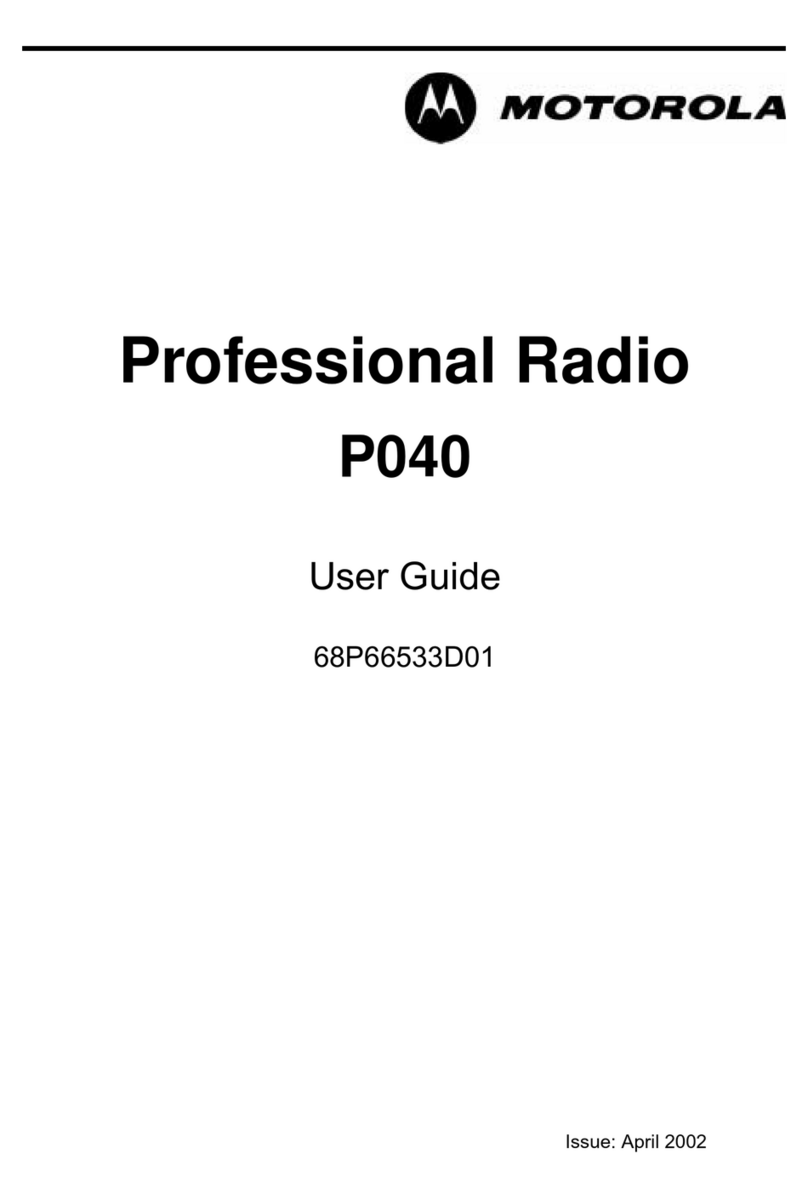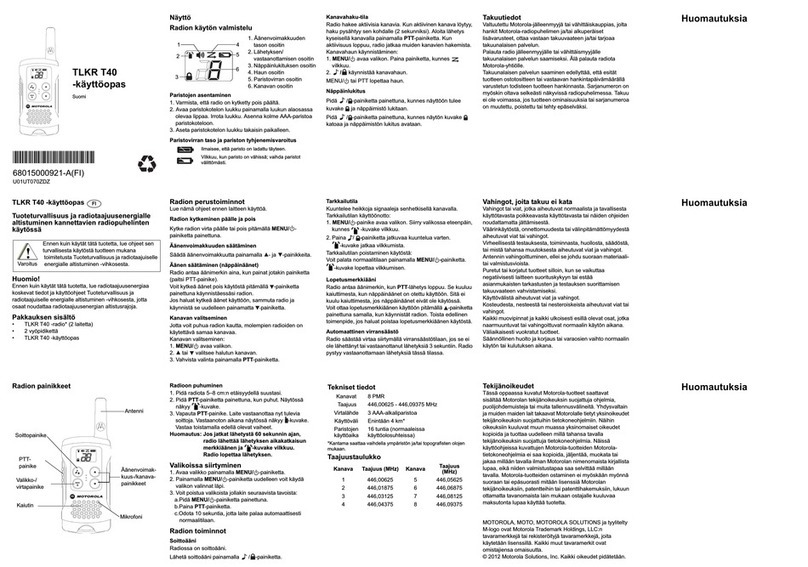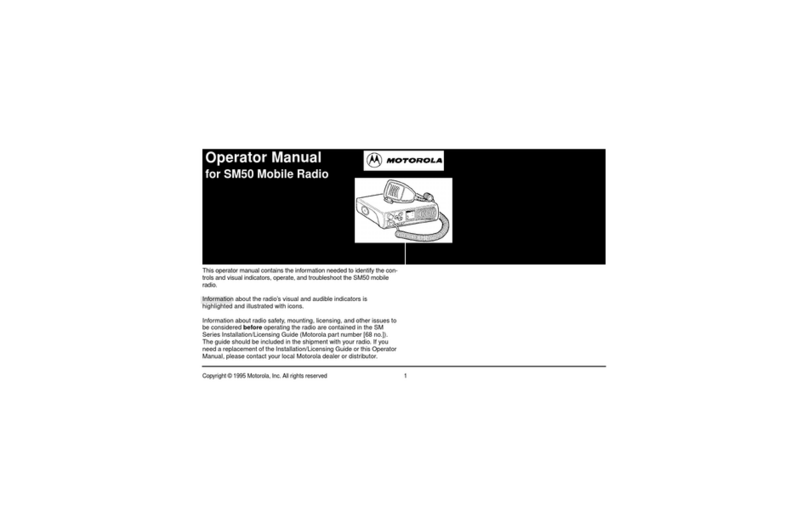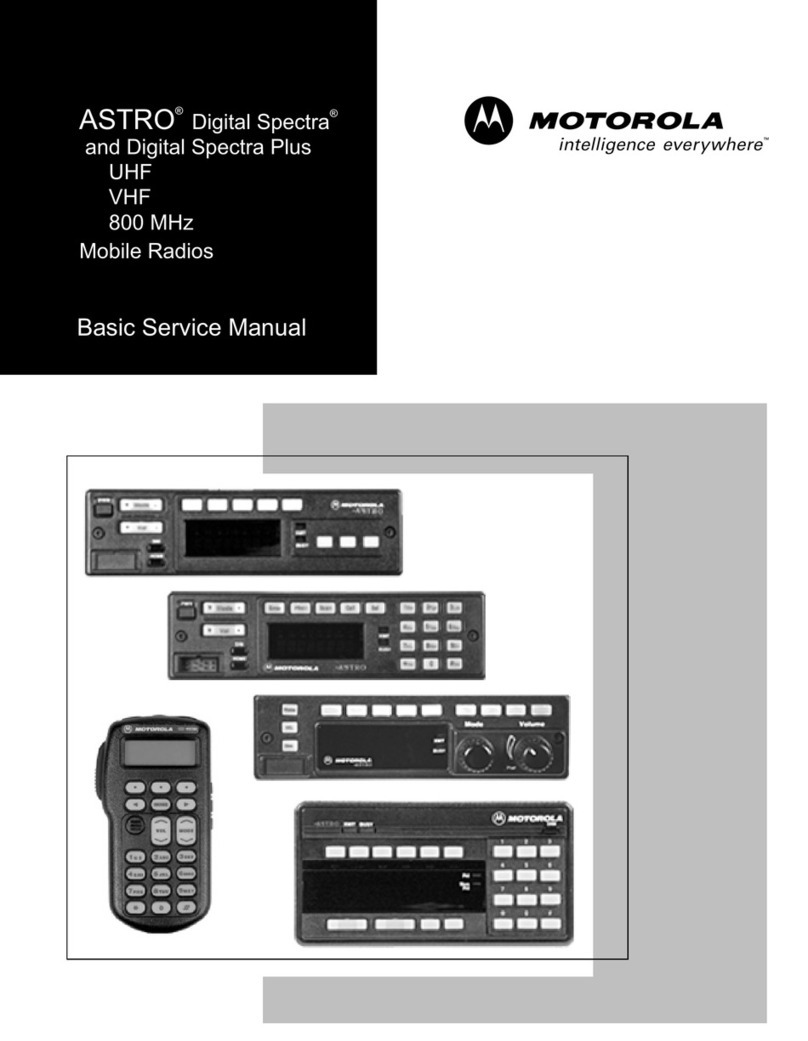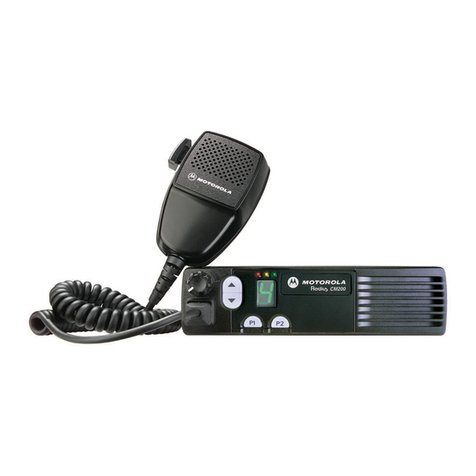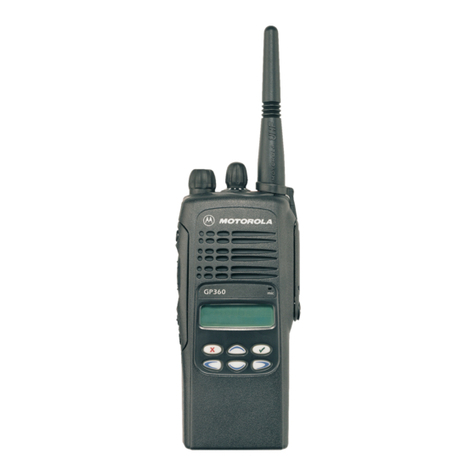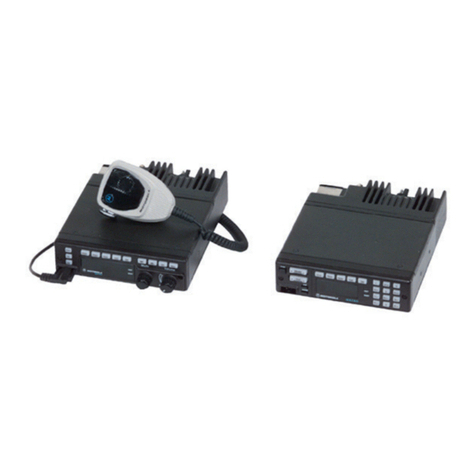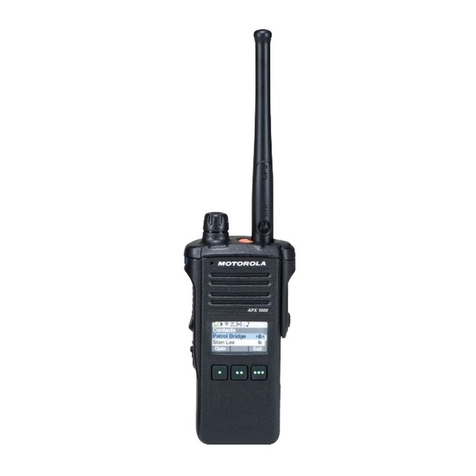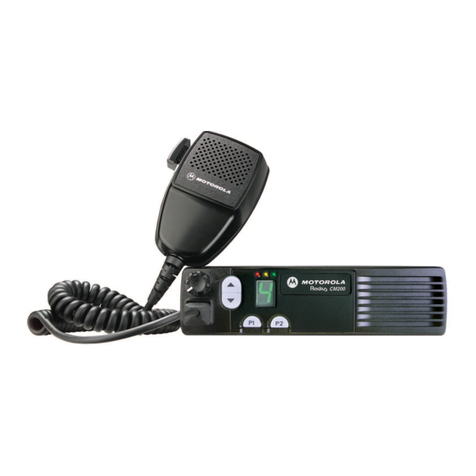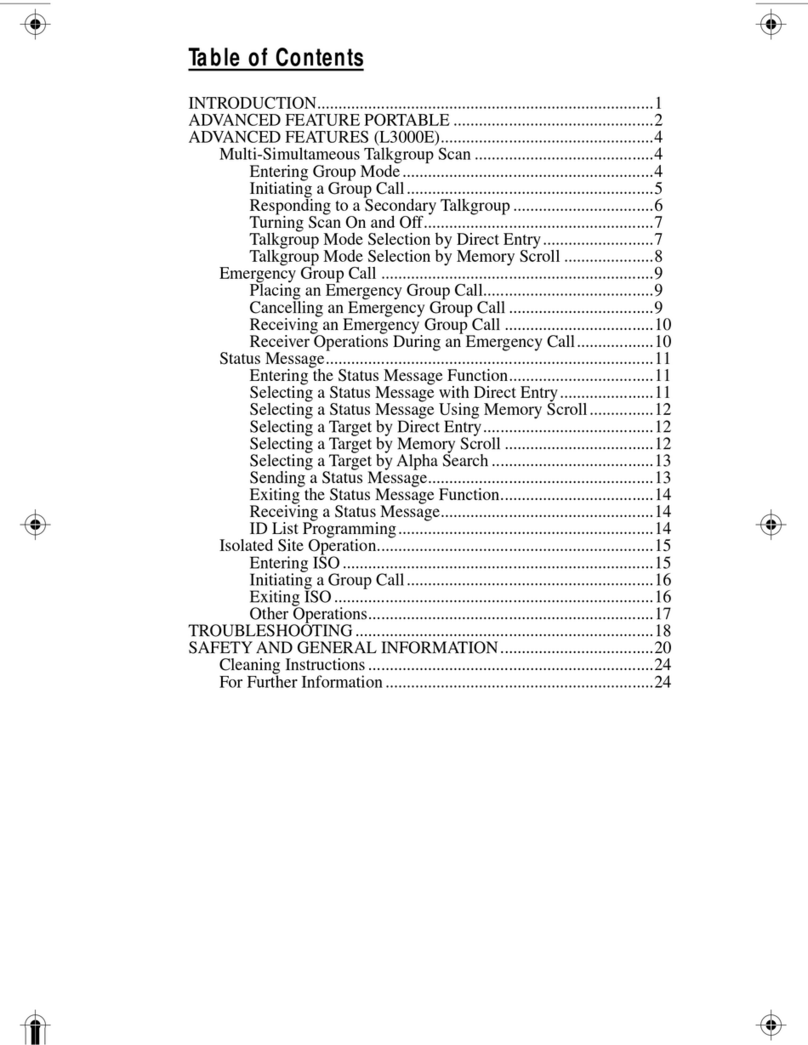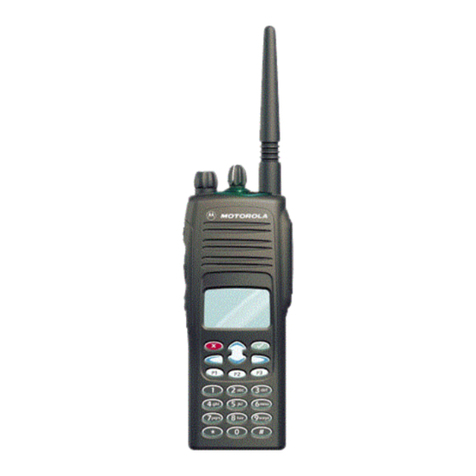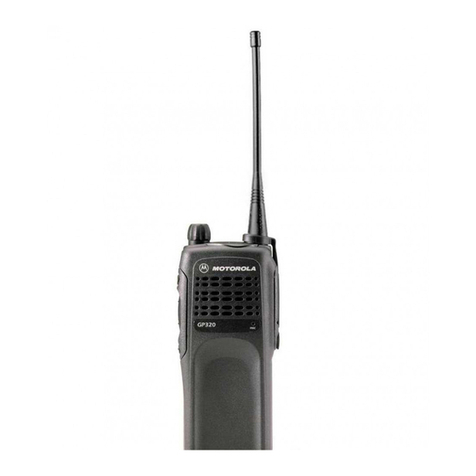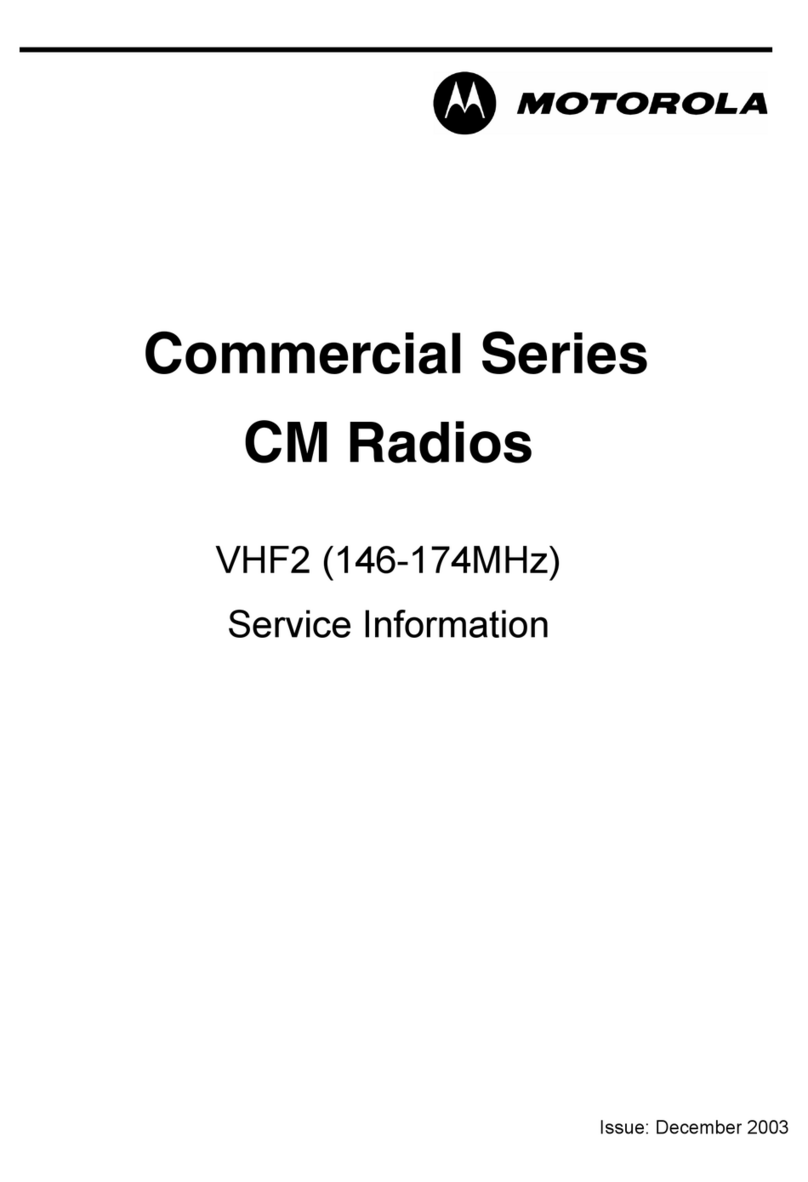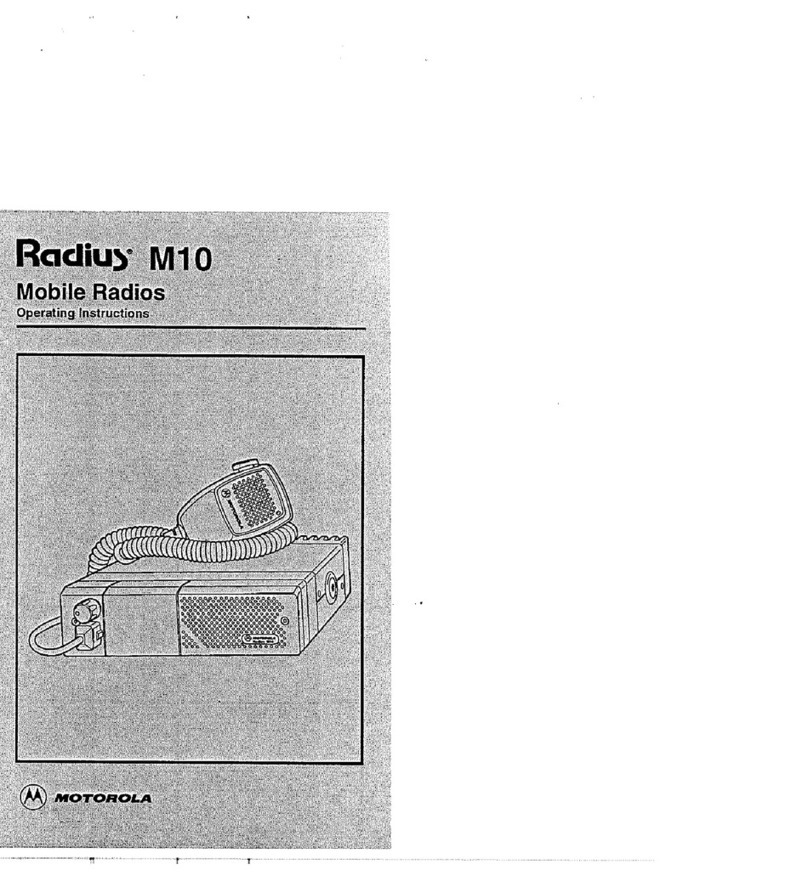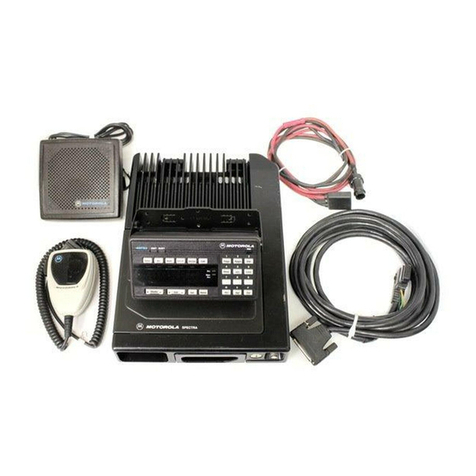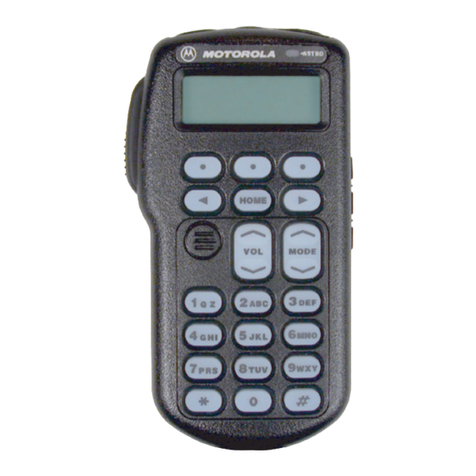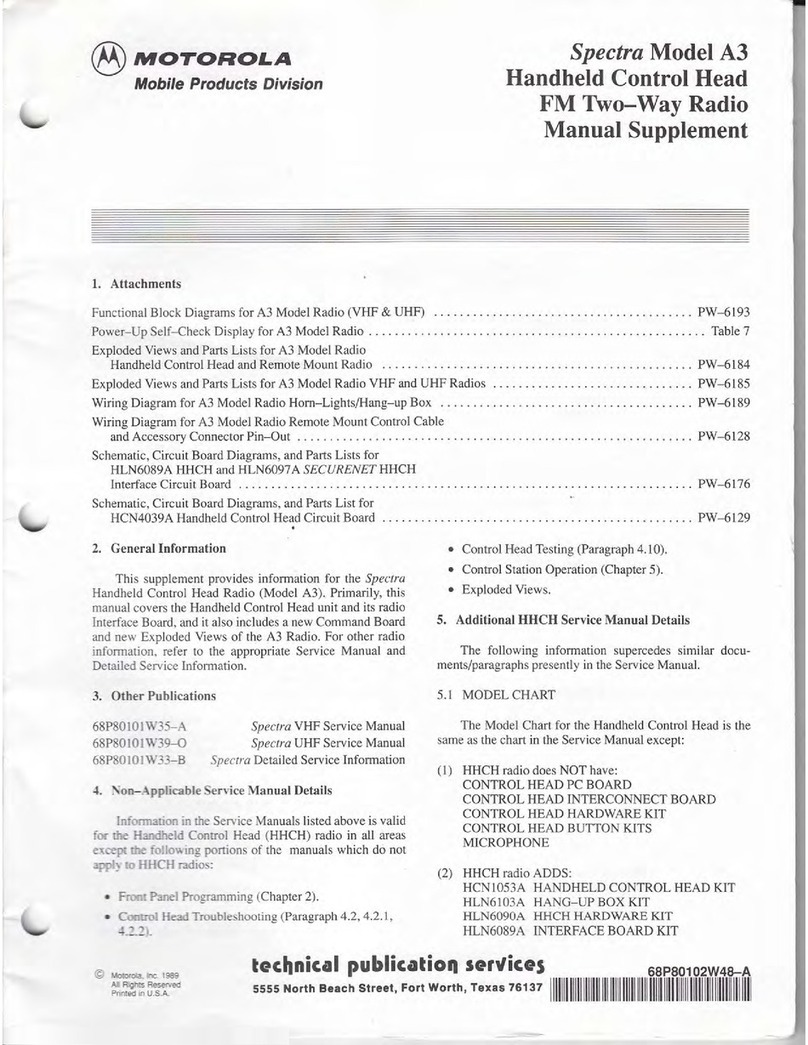
(5) Observe the gauge for approximately two
minutes.
©If the needie falls 2in. Hg or less (for
example, from 5in. Hg to 3in. Hg), then
the radio has passed the vacuum test and
is approved for submersibility. No
additional testing will be required.
©If the needle falls more than 2in. Hg (for
example, from 5in. Hg to less than 3in.
Hg), then the radio has failed the vacuum
test and the radio might leak if
submersed. Additional troubleshooting of
the radio will be required; complete this
procedure, then go to the "PRESSURE
TEST" section of this manual.
(6) Remove the vacuum hose and adapter from
the radio.
6. PRESSURE TEST
Refer to the exploded view diagrams and
parts lists in the applicable service manual.
a. General
Pressure testing the radio is necessary only if
the radio has failed the vacuum test. Do not
perform the pressure test until the vacuum test
has been completed. Pressure testing involves
creating apressure condition inside the radio,
submersing the radio in water, and observing the
radio for astream of bubbles (leak). Since all
areas of the radio are being checked, observe the
entire unit carefully for the possibility of multiple
leaks before completing this test.
b. Conducting the Test
(1) Screw the adapter (with gasket) into the
tapped hole in the baseplate.
(2) Attach one end of the pressure hose to the
adapter and the other end to the pressure
pump.
(3) Operate the pump until the gauge reads
approximately 1psig. Some leak-down is
normal as the pressure equalizes across the
port seal membrane.
(4) Maintain the pressure at 1psig and submerse
the radio into awater-filled container.
(5) Watch for any continuous series of bubbles.
NOTE
Some air entrapment may cause the
accumulation of bubbles, especially in the grille
area, but the bubbles should not be
continuous.
(6) Note all of the seal areas that show signs of
eakage. Pinpoint the problem(s) to one (or
more) of the following areas:
(a) housing
(b) baseplate elastomer seal or vacuum port
seal
(c) antenna bushing seal or
lightpipe seal
(d) frequency switch and on/off/volume
control
(e) rf connector
(f) dual-function switch and actuator
assembly
(g) frame stud seals
(h) main seal
(7) Remove the radio from the water container
and dry it thoroughly. Be especially careful to
dry the area around the main seal to prevent
contamination of the internal electronics while
the unit is open. Also, to keep the area around
the port seal dry, make sure that there is no
water around the baseplate vacuum port.
(8) Remove the adapter and pressure hose
added in steps (1) and (2).
c. Troubleshooting Leak Areas
Before repairing any leak, read all applicable
area repair paragraphs. This will help to eliminate
unnecessary disassembly and reassembly of a
radio with multiple leaks. Troubleshoot only the
faulty seal areas listed in the "PRESSURE TEST"
section, and, when multiple leaks exist, in the
order listed.
NOTE
Before reassembling the radio, always install a
new main seal O-ring, and new O-rings in the
defective area.
(1) Housing
lf aleak occurs in any portion of the housing
assembly (monitor, push-to-talk, or RAT switches,
speaker grille, or universal connector), replace the
housing.
(2) Baseplate Elastomer Seal or Vacuum
Port Seal
(a) These seals can, and should, be repaired
without removing the radio chassis from the
housing assembly. Remove the baseplate by
loosening the slotted-spanner nuts and
removing the center battery contact screw.
NOTE
Before removing the baseplate, note the
location and orientation of the battery latch and
battery latch spring.
(b) Inspect the elastomer seal for damage or
foreign material; replace or clean as
necessary. Remove the old vacuum port seal,
and inspect the sealing surfaces of the
housing and baseplate for damage; replace
any faulty items, and install anew vacuum
port seal.
(c) Ensure that the center O-ring portion of the
elastomer seal is fully seated around the
threaded bushing in the housing. Reassemble
the baseplate with the convex surface of the
latch spring toward the baseplate. Tighten the
battery contact screws and slotted-spanner
nuts to the correct torque.
(3) Antenna Bushing Seal or Lightpipe Seal
(a) Check the antenna bushing spanner nut for
correct torque. If the nut is loose, tighten it to
the correct value and run the pressure test
again. If the nut is not loose, the antenna
bushing must be replaced. This will require
the removal of the main circuit board from the
frame assembly according to the following
procedure:
1. Referring to the "DISASSEMBLY" section
in the applicable service manual,
disassemble the radio until the speaker
bracket assembly is disconnected and
removed from the frame assembly.
2. Read the precautions outlined in the
"SERVICING MAJOR SUBASSEMBLIES"
section of the service manual before
performing steps 3through 8, below.
3. Disconnect the PTT/controls flexible
circuit from the radio circuit board.
4. Remove the back shield.
5. Remove the two bottom connector screws
and three power amplifier module (U202)
screws (one through the PC board, and
two through the frame), securing the main
circuit board.
6. Gently remove the ground clip. If the clip
is bent during removal, replace it.
7. Remove the power amplifier module
(U202).
8. Grasping the main circuit board at the
bottom connector end, lift the board and
carefully slide it out from under the control
top panel.
CAUTION
When the main circuit board is
removed, fragile wireform and ground
contacts are exposed. Handle gently to
avoid damage.
(b) The control top panel must now be removed
from the frame assembly. Remove the two
screws that hold the panel to the side of the
radio frame.
(c) Remove the on/off/volume control and
frequency switch knobs by grasping the tip of
each knob with pliers and pulling the knob off
the shaft of the switch. Open the insert by
inserting ascrewdriver blade into the insert's
slot, then pull the nsert off the shaft. Remove
the torque washer from the volume control, if
necessary.
(d) Remove the detent washer from around the
frequency switch, noting the orientation of the
washer, relative to the switch, prior to removal.
Then, remove the spanner nut from each
switch.
(e) Noting the location of the lightpipe, which will
be loose, lift the control top panel off the
frame.
(f) Remove the antenna bushing spanner nut and
the antenna bushing from the control top
panel. inspect the sealing surfaces on the
control top panel and bushing; replace faulty
items as required. Remove and discard the
old antenna bushing O-ring, and install cea new
one.
CAUTION
Ensure that all static electricity
safeguards are in place prior to
beginning radio disassembly.
(g) Before reassembling the radio, inspect the O-
rings on the lightpipe, on/off/volume control,
and frequency switch for damage and foreign
material. Also, ensure that the lightpipe and
the antenna bushing's hex head are properly
seated in the control top panel.
(h) Reassemble the radio in reverse order of
disassembly, using new frequency switch and
onoff/volume control knobs and inserts.
CAUTION
Pressure any greater than 1psig may push
air around the main seal and may damage
the grille area.
(5) Observe the gauge for approximately two
minutes.
©If the needie falls 2in. Hg or less (for
example, from 5in. Hg to 3in. Hg), then
the radio has passed the vacuum test and
is approved for submersibility. No
additional testing will be required.
©If the needle falls more than 2in. Hg (for
example, from 5in. Hg to less than 3in.
Hg), then the radio has failed the vacuum
test and the radio might leak if
submersed. Additional troubleshooting of
the radio will be required; complete this
procedure, then go to the "PRESSURE
TEST" section of this manual.
(6) Remove the vacuum hose and adapter from
the radio.
6. PRESSURE TEST
Refer to the exploded view diagrams and
parts lists in the applicable service manual.
a. General
Pressure testing the radio is necessary only if
the radio has failed the vacuum test. Do not
perform the pressure test until the vacuum test
has been completed. Pressure testing involves
creating apressure condition inside the radio,
submersing the radio in water, and observing the
radio for astream of bubbles (leak). Since all
areas of the radio are being checked, observe the
entire unit carefully for the possibility of multiple
leaks before completing this test.
b. Conducting the Test
(1) Screw the adapter (with gasket) into the
tapped hole in the baseplate.
(2) Attach one end of the pressure hose to the
adapter and the other end to the pressure
pump.
(3) Operate the pump until the gauge reads
approximately 1psig. Some leak-down is
normal as the pressure equalizes across the
port seal membrane.
(4) Maintain the pressure at 1psig and submerse
the radio into awater-filled container.
(5) Watch for any continuous series of bubbles.
NOTE
Some air entrapment may cause the
accumulation of bubbles, especially in the grille
area, but the bubbles should not be
continuous.
(6) Note all of the seal areas that show signs of
eakage. Pinpoint the problem(s) to one (or
more) of the following areas:
(a) housing
(b) baseplate elastomer seal or vacuum port
seal
(c) antenna bushing seal or
lightpipe seal
(d) frequency switch and on/off/volume
control
(e) rf connector
(f) dual-function switch and actuator
assembly
(g) frame stud seals
(h) main seal
(7) Remove the radio from the water container
and dry it thoroughly. Be especially careful to
dry the area around the main seal to prevent
contamination of the internal electronics while
the unit is open. Also, to keep the area around
the port seal dry, make sure that there is no
water around the baseplate vacuum port.
(8) Remove the adapter and pressure hose
added in steps (1) and (2).
c. Troubleshooting Leak Areas
Before repairing any leak, read all applicable
area repair paragraphs. This will help to eliminate
unnecessary disassembly and reassembly of a
radio with multiple leaks. Troubleshoot only the
faulty seal areas listed in the "PRESSURE TEST"
section, and, when multiple leaks exist, in the
order listed.
NOTE
Before reassembling the radio, always install a
new main seal O-ring, and new O-rings in the
defective area.
(1) Housing
lf aleak occurs in any portion of the housing
assembly (monitor, push-to-talk, or RAT switches,
speaker grille, or universal connector), replace the
housing.
(2) Baseplate Elastomer Seal or Vacuum
Port Seal
(a) These seals can, and should, be repaired
without removing the radio chassis from the
housing assembly. Remove the baseplate by
loosening the slotted-spanner nuts and
removing the center battery contact screw.
NOTE
Before removing the baseplate, note the
location and orientation of the battery latch and
battery latch spring.
(b) Inspect the elastomer seal for damage or
foreign material; replace or clean as
necessary. Remove the old vacuum port seal,
and inspect the sealing surfaces of the
housing and baseplate for damage; replace
any faulty items, and install anew vacuum
port seal.
(c) Ensure that the center O-ring portion of the
elastomer seal is fully seated around the
threaded bushing in the housing. Reassemble
the baseplate with the convex surface of the
latch spring toward the baseplate. Tighten the
battery contact screws and slotted-spanner
nuts to the correct torque.
(3) Antenna Bushing Seal or Lightpipe Seal
(a) Check the antenna bushing spanner nut for
correct torque. If the nut is loose, tighten it to
the correct value and run the pressure test
again. If the nut is not loose, the antenna
bushing must be replaced. This will require
the removal of the main circuit board from the
frame assembly according to the following
procedure:
1. Referring to the "DISASSEMBLY" section
in the applicable service manual,
disassemble the radio until the speaker
bracket assembly is disconnected and
removed from the frame assembly.
2. Read the precautions outlined in the
"SERVICING MAJOR SUBASSEMBLIES"
section of the service manual before
performing steps 3through 8, below.
3. Disconnect the PTT/controls flexible
circuit from the radio circuit board.
4. Remove the back shield.
5. Remove the two bottom connector screws
and three power amplifier module (U202)
screws (one through the PC board, and
two through the frame), securing the main
circuit board.
6. Gently remove the ground clip. If the clip
is bent during removal, replace it.
7. Remove the power amplifier module
(U202).
8. Grasping the main circuit board at the
bottom connector end, lift the board and
carefully slide it out from under the control
top panel.
CAUTION
When the main circuit board is
removed, fragile wireform and ground
contacts are exposed. Handle gently to
avoid damage.
(b) The control top panel must now be removed
from the frame assembly. Remove the two
screws that hold the panel to the side of the
radio frame.
(c) Remove the on/off/volume control and
frequency switch knobs by grasping the tip of
each knob with pliers and pulling the knob off
the shaft of the switch. Open the insert by
inserting ascrewdriver blade into the insert's
slot, then pull the nsert off the shaft. Remove
the torque washer from the volume control, if
necessary.
(d) Remove the detent washer from around the
frequency switch, noting the orientation of the
washer, relative to the switch, prior to removal.
Then, remove the spanner nut from each
switch.
(e) Noting the location of the lightpipe, which will
be loose, lift the control top panel off the
frame.
(f) Remove the antenna bushing spanner nut and
the antenna bushing from the control top
panel. inspect the sealing surfaces on the
control top panel and bushing; replace faulty
items as required. Remove and discard the
old antenna bushing O-ring, and install cea new
one.
CAUTION
Ensure that all static electricity
safeguards are in place prior to
beginning radio disassembly.
(g) Before reassembling the radio, inspect the O-
rings on the lightpipe, on/off/volume control,
and frequency switch for damage and foreign
material. Also, ensure that the lightpipe and
the antenna bushing's hex head are properly
seated in the control top panel.
(h) Reassemble the radio in reverse order of
disassembly, using new frequency switch and
onoff/volume control knobs and inserts.
CAUTION
Pressure any greater than 1psig may push
air around the main seal and may damage
the grille area.
